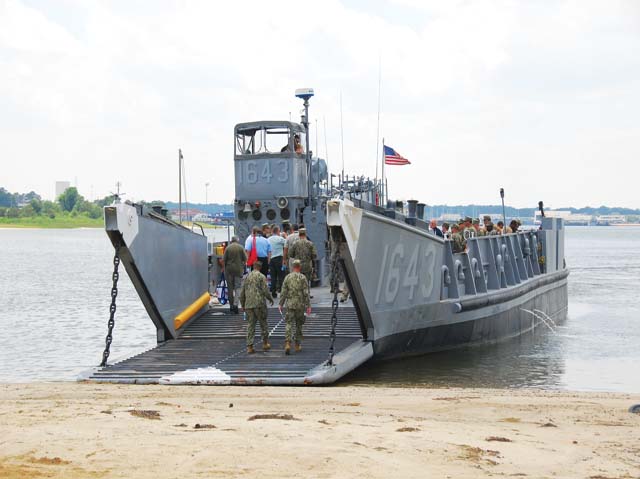The message from government to industry was clear and concise: Affordability.
“Everything revolves around affordability,” said Jay Stefany, executive director for the Amphibious, Auxiliary and Sealift Office at PEO Ships in Washington, D.C. Stefany was the first of three keynote speakers at the 2014 Multi-Agency Craft Conference (MACC) held at JEB Little Creek-Fort Story in Virginia Beach, Va.
A popular annual event for many years, MACC had been on hiatus since 2011 before returning to Little Creek in June.
“Every dollar is scrutinized,” Stefany continued. “We need the industry to reduce costs while also responding to our evolving requirements.”
Jean-Michel Coughlin, a manager at the Navy’s Support Ships, Boats and Craft Program Office (PMS 325) within PEO Ships, reinforced Stefany’s austerity message. “You’ve heard of doing more with less,” he said, “now you need to do more with a lot less.”
Even with these warnings, the federal government will, of course, continue to purchase vessels and other equipment from the commercial marine industry. Some projects on the horizon include more research vessels for NOAA and the replacement of some Navy fleet tugs. The Navy also wants to replace its aging fleet of LCUs (Landing Craft Utility), one of which was available for an industry tour during the conference.
Tom Rivers, deputy program manager for the Navy’s Amphibious Warfare Program Office (PMS 377) in Washington, D.C., told MACC attendees that the Navy would like to have the first new LCU, also known as a Surface Connector, by fiscal year 2018. The SC(X)R Request for Information went out about a year ago and RFPs are anticipated by fiscal 2017.
The current fleet of LCU 1610s was built in the 1960s and clearly shows it age. The 135'×30' landing craft can carry troops, tanks, trucks and equipment from ships to shore. According to Rivers, any replacements would probably have capabilities similar to the existing LCU 1610 class, which includes a 1,200 NM range, 10-day endurance, speed of 8 knots cruising/11 knots max, accommodations for a crew of 13 and a cargo capacity of 170 ST.
“These are little ships,” said Rivers. “They need to be easily maintainable, simple to use and easy to repair. We’re looking for mature, green technologies and emissions that meet EPA and IMO regulations. We’re also looking for ideas because we don’t have a perfect solution in mind.”
SOLICITATION ADVICE
Roxie Thomas, a NAVSEA contracting officer who buys small boats for the Navy, had some specific advice for would-be suppliers during a technical session at MACC.
“Read the solicitation,” she said. “You’d be surprised by the number of people that apparently don’t read the full solicitation and then don’t respond to all the requirements.” She recommended creating a spreadsheet for any given solicitation that includes all requirements. “We’re trying to level the playing field and use the same criteria for everyone.”
Thomas also said that the feds are shifting away from the General Services Administration (GSA) and making more purchases through FAR (Federal Acquisition Regulation) Part 12. “We’re not walking away from GSA,” she said, “we’ve just moving to FAR12, which is open to all in the industry.”
She also encouraged respondents to RFPs to demonstrate that prices are fair and reasonable. “Show us previous invoices,” she said. “ Help us understand your math and technical information.”
Thomas also cautioned that federal budgets don’t equal contract value. “Assumptions are not a good thing,” she said, noting that many other costs get subtracted from a budget item before it goes out to bid.
COMBATANT CRAFT
Representatives of the Common Maritime Technology Working Group provided MACC attendees with an overview of the group’s activities. Marine Corps Col. Daniel Ermer chaired the panel that works with industry to develop new technologies with maritime applications.
The group reviews proposals and has the authority to fund projects it feels have “game-changing potential,” according to Ermer. The group is particularly interested in combatant craft and considers the needs of all services. And for those craft, the group is especially interested in shock-mitigating seating and communications systems for boat crews. “It’s a noisy environment out there,” said Cmdr. Rich Condit of the Coast Guard, “and we want something that works great, whether wireless or wired, encrypted or unencrypted. We’re not quite there yet, but we’re on track to find what we need, which includes uniformity that becomes second nature to the crews.”
Weapons mounts are another hot topic. “The bow is not a great place for weapons in a small boat because it gets in the way of the coxswain,” said Condit. “I foresee getting gunners off the bow. Maybe we’ll have remote-controlled weapons on top.”




